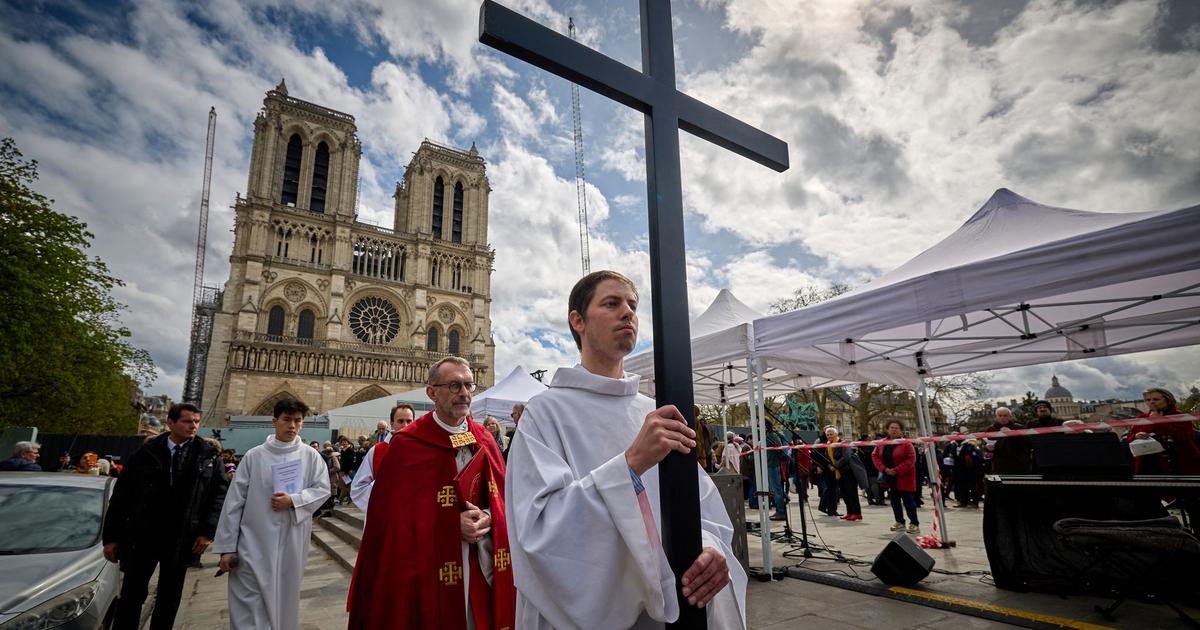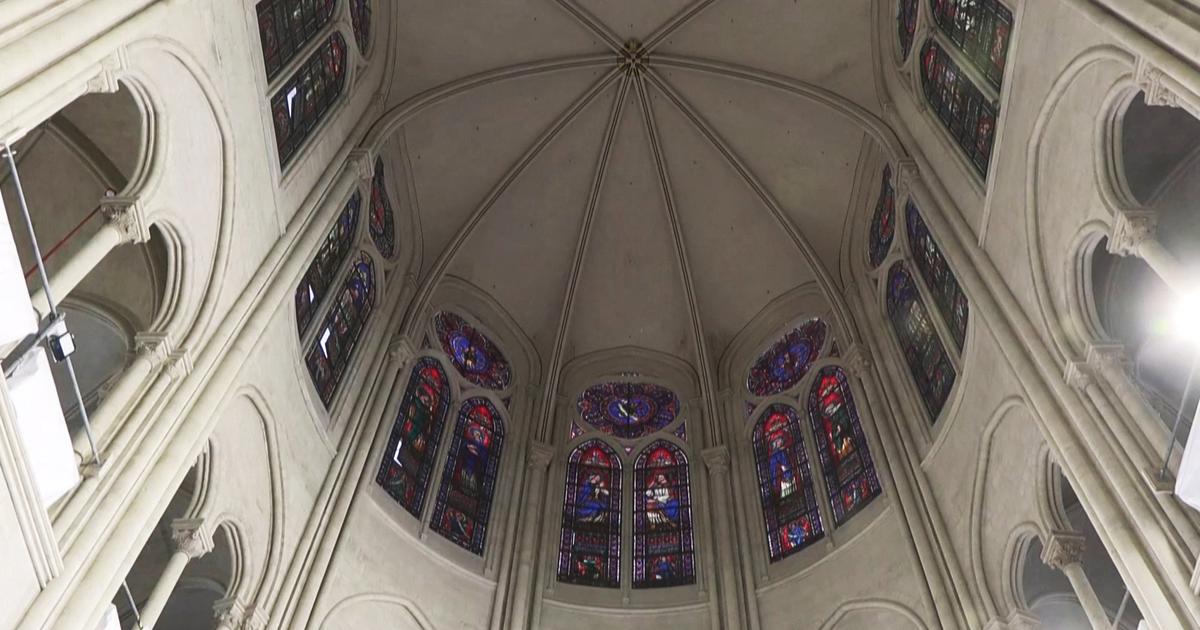Notre Dame Cathedral in Paris was the tallest building of its time.
Devastated by fire in April 2019, the burning of the iconic seo has revealed one of its secrets: the use of iron in its construction.
The master stonemasons who built it in the 12th century used thousands of large metal staples that helped support such a high structure made up of large stone blocks without it collapsing.
The dating of the metal indicates that the metal was already used at the start of construction.
Later great buildings, especially Gothic cathedrals, introduced the innovation of Notre Dame into their walls.
A group of scientists specialized in the so-called archaeometallurgy has had the opportunity to closely study the Notre Dame staples.
They have only been allowed to analyze a dozen, some detached due to the fire.
But the fire has left dozens visible in the stands (the second level of the cathedral) and many others from the upper walls.
Maxime L'Héritier, a medieval historian at the University of Paris 8 and an expert in the history of construction, says that, counting the visible and accessible ones, they counted 280. “But including those that could not be seen on the same levels or embedded in the masonry of the checkered cornice, it would be a few thousand staples in total”.
"Including the ones that couldn't be seen on the levels or embedded in the masonry of the checkered cornice, it would be a few thousand staples."
Maxime L'Héritier, medieval historian from the University of Paris 8
Modern iron smelting did not emerge until the 19th century, but since ancient times, charcoal has almost always been used in furnaces to work and forge the iron for swords, armor, plows, and household utensils.
In this process, part of the carbon in the coal interacts with the metal, giving rise to what centuries later would be steel.
L'Héritier and his colleagues took advantage of this process called carburization to apply the radiocarbon dating technique to the staples.
As published in the scientific journal
PLoS ONE
, those in the stands are from around 1160 and there are others from several decades later.
The Bishop of Paris, Maurice de Sully, started the works in 1163, so the dates fit.
The cathedral was almost finished a century later, but it was not until 1345 that it was finished.
The presence of these staples already in the initial phases of construction reveals, for L'Héritier, the relevance of iron at the base of Gothic cathedrals.
"Various metallic materials (iron or bronze) were already occasionally used in ancient temples or theaters," acknowledges the French historian.
For example, the Colosseum in Rome has metal staples.
“However, the type of construction is very different, with huge stone blocks without mortar.
Staples were only used for construction purposes (to keep the stone blocks aligned).
In Notre Dame and other Gothic churches the height and slenderness of the constructions are sought.
All building materials and architectural elements therefore play a dynamic role in the search for stability.
So,
Interior of the burned cathedral, with the staples on a wall in the foreground, on the left. Maxime L'Héritier
The stonemasons and architects who raised the cathedral to a height of 32 meters in the central nave and 69 meters in the two towers used the staples to be able to raise it so high.
“Iron provides various types of reinforcements.
It seems that in many cases it has an important role for the construction phase, when the building is not fully supported and loaded”, says L'Héritier.
The staples are not as one imagines them (see photo).
These are iron bars weighing up to one meter and four kilograms, which joined two blocks together.
In the Parisian cathedral, they have been found in the stones of the upper walls, the tribunes and the choir, which does not rule out that they were also used on the lower floor.
"Notre Dame seems to be the first Gothic church to make use of these iron elements," adds the French scientist.
It would be necessary to wait for the 13th century for the other great French cathedrals, such as those of Reims or Chartres, to also use iron, following in the footsteps of the Paris cathedral.
As early as the fourteenth century, cathedrals such as the one in Prague or the one in Milan used iron.
It also appears in non-religious buildings, such as the papal palaces in Rome or the château de Vincennes, the castle of the French kings, a reflection of their emerging power.
But times seem to have changed and the metal, hidden in Notre Dame, is already showing, the iron parts of the buildings being visible.
The detailed analysis of the staples yields both new certainties and uncertainties.
In its composition, in addition to iron, there are small amounts of a dozen materials (cerium, europium, niobium...).
The different ratio of elements has allowed the researchers to ensure that the material with which the staples were made came from at least six different parts of Europe.
As for the mystery, “prior to our analyses, we expected that these 3-4kg staples would have been made from a single piece, since iron production in medieval times could easily produce such an amount of iron in a single piece.” oven;
however, the welds show that almost all the clips were forged by assembling several pieces”, says L'Héritier.
But they don't know why.
It could be a sign of recovery and recycling of a material that was not cheap and affordable at the time, "but it seems strange to us that a construction as rich as Notre Dame's used exclusively recycled iron," recalls the French historian.
And he adds: “We have not clarified this yet,
"The builders must have used iron to try to reduce the movements of the stones, to give it stability"
Rocío Maira Vidal, researcher at the Institute of History of the Center for Human and Social Sciences (CSIC)
For Rocío Maira Vidal, a researcher at the Institute of History of the Center for Human and Social Sciences (CSIC), "the builders had to use iron to try to reduce the movements of the stones, to give it stability."
It was like a preventive action, "if any crack or displacement occurred, it gave them a false sense of security, of stability," adds the architect, who published a book in 2021 on the costs of medieval constructions.
What Vidal denies is that they used iron to maintain "the structure while they built the cathedral."
Vidal remembers that the iron had and has a problem, that it rusts.
And when the iron rusts, in a process accelerated by the water present in the mortar used to fix it to the rock, it bursts whatever is around it, imprisoning it, as can be seen in many poor coastal constructions.
Vidal is convinced that the architects of Notre Dame knew this.
The heritage restorer also mentions the cases of Westminster Abbey, where English kings have been crowned for centuries, and the Holy Chapel in Paris, both built decades after Notre Dame: both had to be restored.
The abbey had all its metal cleats removed the following century.
But at Notre Dame, "most of the staples from the upper walls are being reused in the ongoing restoration," L'Héritier points out.
So they must not be very rusty.
Iron corrosion problems may have been known, but the Paris cathedral seems to have been able to avoid them.
As the French scientist adds, adding lead to iron materials slows down oxidation, especially if a good seal is produced.
“So I don't think the builders cared about rusting the iron,” he finishes.
You can follow
MATERIA
on
,
and
, or sign up here to receive
our weekly newsletter
.
Subscribe to continue reading
Read without limits
Keep reading
I'm already a subscriber

/cloudfront-eu-central-1.images.arcpublishing.com/prisa/24M27B4ZOVAWHC7JVVMS3AHZE4.jpg)







